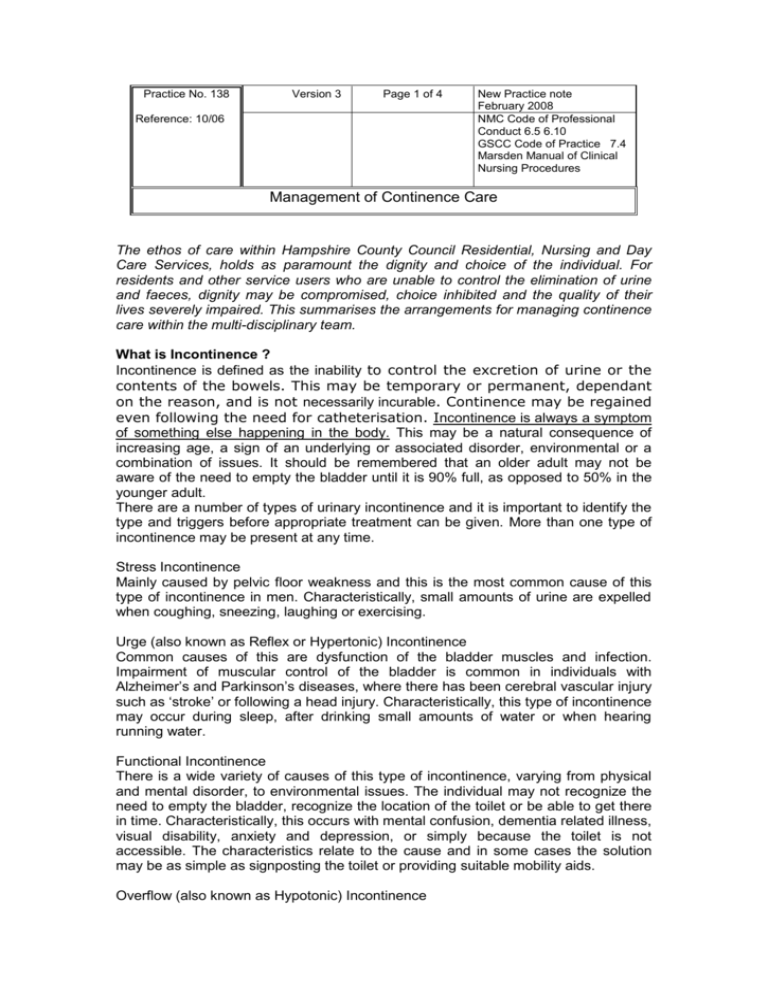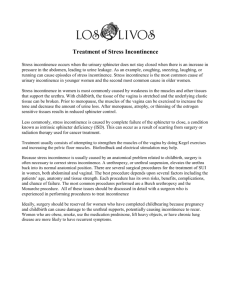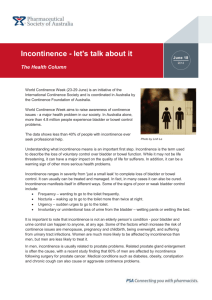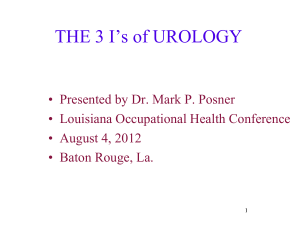Management of continence care 48kb
advertisement

Practice No. 138 Version 3 Page 1 of 4 Reference: 10/06 New Practice note February 2008 NMC Code of Professional Conduct 6.5 6.10 GSCC Code of Practice 7.4 Marsden Manual of Clinical Nursing Procedures Management of Continence Care The ethos of care within Hampshire County Council Residential, Nursing and Day Care Services, holds as paramount the dignity and choice of the individual. For residents and other service users who are unable to control the elimination of urine and faeces, dignity may be compromised, choice inhibited and the quality of their lives severely impaired. This summarises the arrangements for managing continence care within the multi-disciplinary team. What is Incontinence ? Incontinence is defined as the inability to control the excretion of urine or the contents of the bowels. This may be temporary or permanent, dependant on the reason, and is not necessarily incurable. Continence may be regained even following the need for catheterisation. Incontinence is always a symptom of something else happening in the body. This may be a natural consequence of increasing age, a sign of an underlying or associated disorder, environmental or a combination of issues. It should be remembered that an older adult may not be aware of the need to empty the bladder until it is 90% full, as opposed to 50% in the younger adult. There are a number of types of urinary incontinence and it is important to identify the type and triggers before appropriate treatment can be given. More than one type of incontinence may be present at any time. Stress Incontinence Mainly caused by pelvic floor weakness and this is the most common cause of this type of incontinence in men. Characteristically, small amounts of urine are expelled when coughing, sneezing, laughing or exercising. Urge (also known as Reflex or Hypertonic) Incontinence Common causes of this are dysfunction of the bladder muscles and infection. Impairment of muscular control of the bladder is common in individuals with Alzheimer’s and Parkinson’s diseases, where there has been cerebral vascular injury such as ‘stroke’ or following a head injury. Characteristically, this type of incontinence may occur during sleep, after drinking small amounts of water or when hearing running water. Functional Incontinence There is a wide variety of causes of this type of incontinence, varying from physical and mental disorder, to environmental issues. The individual may not recognize the need to empty the bladder, recognize the location of the toilet or be able to get there in time. Characteristically, this occurs with mental confusion, dementia related illness, visual disability, anxiety and depression, or simply because the toilet is not accessible. The characteristics relate to the cause and in some cases the solution may be as simple as signposting the toilet or providing suitable mobility aids. Overflow (also known as Hypotonic) Incontinence The main cause of this is weakness/inefficiency of the bladder muscles or obstruction of the urethra. The bladder is constantly full as it cannot empty efficiently, and consequently overflows. This type of incontinence occurs in individuals with conditions such as Diabetic neuropathy, enlargement of the prostate gland, severe vaginal prolapse, spinal injury and faecal impaction. The usual cause of faecal incontinence is a damaged or inefficient anal sphincter. Other common causes include :Constipation / faecal impaction This leads to an overflow of liquid faeces from higher in the bowel. Poor nutrition such as insufficient fibre or fluid in the diet can create this situation. Reduced mobility has a similar effect. Diarrhoea An increased acceleration of movement through the bowel can result in insufficient warning of the need to evacuate. Food poisoning / allergy, irritable bowel syndrome and some medication such as antibiotics may cause diarrhoea. Excessive use of laxatives and some medications These may cause loss of muscle tone or irritation of the digestive tract, resulting in both diarrhoea and constipation. e.g. Iron and antibiotics Neurological and nerve damage Cerebral vascular incidents such as a stroke, may damage the nerve pathways to the bowel, in which case the individual may not be aware of the need to evacuate. Confusion Where poor health creates confusion or forgetfulness, this may cause the individual to forget to go to the toilet. Management of Continence Primarily, it should be remembered that individuals are often reluctant to acknowledge that incontinence is a problem, and may be too embarrassed to discuss it or be fearful of having to wear ‘nappies’. A variety of medical, emotional and social problems often accompany incontinence, including rashes, pressure sores, offensive odours and urinary tract infections. There may also be disturbed sleep, self restriction or exclusion from social interaction and loss of self esteem, possibly leading to depression and increased risk of self neglect and falls. With consideration of the dignity of the service user, the subject should be broached tactfully and in private, and the service user reassured that investigation of the cause will help in resolving the problem. In all cases, the service user’s consent to investigation and treatment should be sought and recorded. Treatment without consent is only permitted where consent cannot be obtained following discussion and the provision of information. In this case the requirements of the Mental Capacity Act 2005 should be followed. In such a situation, any actions taken must be in the best interest of the individual, bearing in mind that best practice and best interest may not be the same. This summarises the practice pathway to follow if there is concern that a service user is incontinent to any degree :- 1. 2. Identify the type or types of Incontinence and possible reasons : Is there a cause which prevents the individual getting to or using the toilet e.g. is the toilet easily accessible, can the individual identify the toilet – is it signed / does the individual get disorientated, is there an underlying mobility of communication problem ? Is there a history of incontinence, when and how did it start ? Is there an obvious medical condition that might be causing the incontinence – e.g. dementia, urinary infection ? Is current medication contributing to the incontinence – e.g. large dosages of diuretics? Conclusions and actions taken should be recorded in the service user’s personal file. Support and encourage the individual at all times : Ensure that need can be clearly indicated, if necessary using signs or written aids for the service user. Respond promptly to requests for help. Encourage fluid intake to prevent dehydration. Promote and where necessary assist with good personal hygiene to avoid infection and deterioration of the condition of the skin. Where problems with access to the toilet can be eliminated In Residential services A sample of urine should be obtained for analysis, to eliminate infection A visit from the General Practitioner should be requested In Day Care The primary carer should be informed of the concern Conclusions and actions taken should be recorded in the service user’s personal file. 3. A specimen of urine should be obtained from the individual and sent for analysis, to eliminate infection as an underlying cause. 4. A ‘Continence diary’ should be kept for the individual for at least one week, to record the time and amount of fluid intake and output. Also the times when the service user is incontinent or has managed elimination successfully. The diary should also record activity or relevant factors associated with the incontinence. This information will assist in diagnosis of the cause and consequent treatment and management. 5. Ensure that the individual is referred to the specialist service. The need for this to be done will vary dependent on whether this is a nursing, residential or day care unit For both residential and care units, the procedure is the same when referring to the specialist service. Contact the PCT Continence Advisor at the contact number for the relevant unit. The Advisor will make an assessment and order the necessary equipment e.g. pads for the individual. 6. 7. Review and Revise the Care Plan This will necessarily be aimed at resolving the specific problem, but should also address all possible reasons for the incontinence until a diagnosis of cause can be made by the GP or specialist nurse. In addition to the ‘diary’ there may be a need for prompting; reviewing MUST assessments: reviewing moving and handling assessments and mobility issues; ensuring that the individual does not become isolated. Implement the specialist advice This should be recorded on the individual’s personal file. The service user should be informed of the process to be implemented and consent should be obtained. At all times the service user should be fully involved in his/her personal care and management of the incontinence. The Care plan will need further review and may need further revision. Monitor and record the outcomes. Review actions and outcomes as required or at an agreed, recorded time e.g. in a week.



